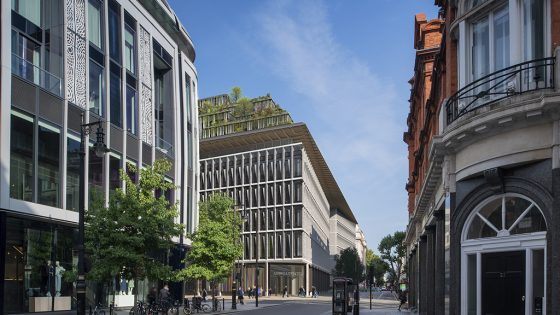Communities secretary Angela Rayner has approved the controversial demolition of Marks & Spencer’s 1920s-built store on London’s Oxford Street.
Yesterday (5 December), she ruled that the retailer could press ahead with its plan to replace the building with a 10-storey office scheme by Pilbrow & Partners, reported Construction News’ sister title Architects’ Journal.
Rayner’s Tory predecessor, Michael Gove, blocked M&S’s plan to demolish the store in July 2023, but his decision was quashed by a High Court judge in March 2024.
The ruling meant the case had to be returned to the secretary of state to be redetermined. With the change of government this summer, the final decision fell to Rayner.
M&S’s proposal for the shop near Marble Arch would see three buildings on the prominent corner site next to Selfridges demolished and replaced with a 10-storey store and office block.
Because of the upfront carbon cost of new construction, such a move would release almost 40,000 tonnes of embodied carbon.
The carbon impact of the proposal was highlighted by Gove in his reasons for refusal last year, along with heritage and design concerns.
The High Court’s decision to overturn this on 1 March followed an M&S appeal on procedural grounds, which involved the retailer having to prove to the High Court that Gove had made an error in his decision-making.
In her judgment, Mrs Justice Lieven ruled that M&S had succeeded in five out of six grounds for appeal.
Having reappraised the plans and the planning inspector’s report, Rayner has now approved the application. In terms of the loss of buildings and impact on the surrounding historic environment, she claimed the “benefits of the proposal outweigh the harm to the significance of the designated heritage assets”.
She acknowledged that the scheme’s embodied carbon and the fact that the required demolition would, in part, fail to “support the transition to a low carbon future” weighed against the proposal, as per paragraph 157 (formerly paragraph 152) of the National Planning Policy Framework.
However, Rayner argued that those issues had to be set against the “advantages of concentrating development in such a highly accessible location”, the employment and regeneration benefits, and the “potential harm to the vitality and viability” of London’s West End that could follow a refusal of permission.
Responding to Rayner’s decision, M&S chief executive Stuart Machin said: “I am delighted that, after three unnecessary years of delays, obfuscation and political posturing at its worst under the previous government, our plans for Marble Arch – the only retail-led regeneration proposal on Oxford Street – have finally been approved.
“We can now get on with the job of helping to rejuvenate the UK’s premier shopping street through a flagship M&S store and office space, which will support 2,000 jobs and act as a global standard-bearer for sustainability.”
He added: “We share the government’s ambition to breathe life back into our cities and towns, and are pleased to see they are serious about getting Britain building and growing. We will now move as fast as we can.”
Pilbrow & Partners founder Fred Pilbrow described the decision as “long overdue” and echoed Machin’s words. telling AJ: “We can now get on with the job of helping to rejuvenate the UK’s premier shopping street through a flagship M&S store and office space, which will support 2,000 jobs and act as a global standard-bearer for sustainability.”
Henrietta Billings, director SAVE Britain’s Heritage, described the decision as a “missed opportunity”.
She said: “The government has chosen the easy option – business as usual – when it had a real chance to show leadership and ambition on this urgent issue. Our old, wasteful knock-it-down-and-start-again model is broken. There is a real appetite in the construction sector for change. They’re crying out for clarity from government.”
She added: “Reusing buildings is great for the planet, great for communities – and it’s also great for growth. Just look at the cultural powerhouse that is Tate Modern, or converted department stores across the country, or the great Pennine textile mills that are once again a driving force in their local economies as commercial space or homes.
“It is wilfully myopic not to see that the elegant M&S building could play a similar role in the story of Oxford Street, whose fortunes are already on the up.”

